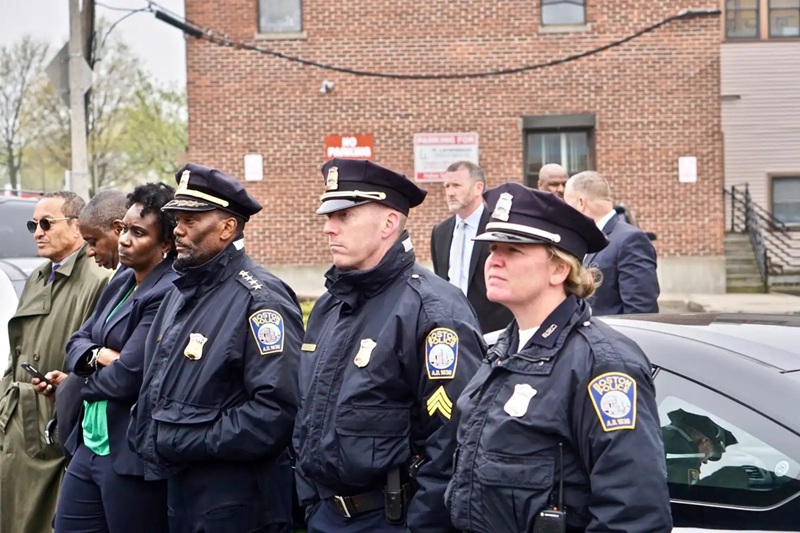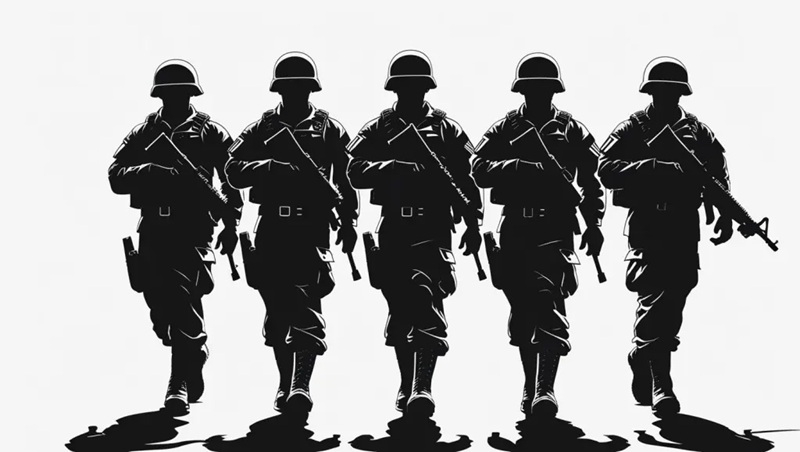Making war in US communities: Trump executive order on policing threatens to set public safety back decades
BY JIM JORDAN

Police-community partnerships have made huge strides in reducing crime and building local trust in law enforcement. The president’s effort to militarize policing would throw it all out the window.
Boston police have been leaders in the rethinking of law enforcement that has emphasized building partnerships with the community. (Photo by Michael Jona
PRESIDENT TRUMP’S reckless order to deploy National Guard and Marine forces to Los Angeles, where protests recently broke out over ICE arrests of immigrants, has rightly drawn indignation as well as legal challenge. His unilateral decision to send military personnel into a US city, bypassing the role of the state’s governor in authorizing use of the National Guard, is the latest sign of the creeping authoritarianism taking hold in Trump’s second term.
But another Trump initiative ostensibly concerned with public safety is ultimately even more troubling than his effort to have military personnel — trained for warfare — deployed to handle domestic law enforcement. Trump is also seeking to militarize the approach of the more than half a million sworn police officers charged with protecting and serving communities across the country every day.
Amid the nonstop flurry of executive orders Trump has issued since returning to the White House is one related to policing that has received scant attention.
In the 879-word executive order, issued in late April, Trump practically previewed his recent deployment of military personnel to Los Angeles. The order, titled “Strengthening and Unleashing America’s Law Enforcement to Pursue Criminals and Protect Innocent Citizens,” is rooted in Project 2025, the omnibus plan of the radical right, published by The Heritage Foundation and aimed at remaking American government and society.
It should set off alarms among everyone, starting with dedicated police officers themselves, who is committed to public safety and best practices in law enforcement.
The executive order calls for a militarized police service in the US, one that essentially operates under martial law. In the order, Trump says the attorney general and secretary of defense, working in consultation with the secretary of homeland security and other agencies, “shall increase the provision of excess military and national security assets in local jurisdictions to assist State and local law enforcement.”

It further calls on the attorney general to “take all appropriate action to create a mechanism to provide legal resources and indemnification to law enforcement officers who unjustly incur expenses and liabilities for actions taken during the performance of their official duties to enforce the law. This mechanism shall include the use of private-sector pro bono assistance for such law enforcement officers.” (So, we now know one of the “causes” the Trump administration intends to assign to the high-priced law firms they pressured into offering free legal services.)
Perhaps most troubling is the order’s effort to undo the crucial role the federal government has played in monitoring troubled local police departments. It orders the attorney general to review, within 60 days, all ongoing consent decrees, a key instrument used by the Department of Justice to remedy systemic civil rights violations in individual police departments, and to “modify, rescind, or move to conclude such measures that unduly impede the performance of law enforcement functions.”
Far from fulfilling his vow to make a positive difference for public safety, Trump’s order would wipe out four decades of crime-reduction strategies and improvements in the overall quality of policing in US communities. During that time, we have seen dramatic reductions in violent crime across the country. The president bases his actions on the falsehood he continually repeats that crime is escalating in America’s neighborhoods. He portrays US cities, especially those in blue states, as post-apocalyptic, violent fantasy lands. (Historically, violent crime has been highest in the very red South.)
Many people in public life, including police themselves, have used martial terms as either metaphors or descriptors, however inapt, in discussing policing. For decades we have claimed to be waging a “war on crime,” while simultaneously carrying out a “war on drugs.” Yet, as the late policing scholar George Kelling told me, “so-called ‘crime-fighting’ failed completely to reduce crime, the outcome it promised.” Indeed, crime and martial rhetoric rose in tandem with one another from the 1950s into the late 1990s.
But the Trump strategy aims to take all the war talk into a new realm, seeking to transform American police departments into something that more closely resembles armed forces units patrolling our neighborhoods.
The tone and language of the order are angry and threatening. “Unleashing” suggests officers snarling and growling at suspects, necks strained against the leash of what it says are “‘diversity, equity, and inclusion’ initiatives that restrict law enforcement activity or endanger citizens.” In the order, the president calls on officers to police more “aggressively,” “tenaciously,” and “firmly,” the clear message being that they should be unchecked by laws and left-wingers. Departments are to be provided war-making equipment and supported in their military approach by undefined “surge resources.”
The order’s talk of “indemnification” for police threatens local and state elected officials for what the president sees as unfair treatment of police personnel accused of violating laws and procedures. In his telling, officers under investigation for any sort of alleged misconduct or wrongdoing are ipso facto the victims, “wrongly accused and abused by State or local officials.”
One can readily insert the terms “Massachusetts” and “Boston” into the executive order where he directs the Justice Department to investigate and prosecute state and local officials who, in the view of Trump’s Justice Department, are interfering in some way with law enforcement.
The order to rescind federal consent decrees overseeing police departments is a grave disservice to, and indeed a threat to the safety of, the hundreds of thousands of good cops who show up each day and night trying to do the right thing. The progress we have made, in Massachusetts and across the country, in operating departments that are responsive to and respectful of the communities they serve is rooted in a commitment to community-police collaboration. Pitting police and communities against one another makes everyone less safe.
The subject and language of presidential pronouncements are always highly consequential. When it comes to the subject of policing, we have firsthand experience of that in Boston.
When President Clinton visited Boston in 1997 to highlight the city’s efforts – based on strong police-community collaboration — to reduce youth firearm violence, he said he wanted to “give every community the tools that you have used to make your city safe again so that we can do it everywhere in America.”
That presidential attention spurred a change in public safety practice across the country, as formerly siloed operations evolved into today’s collaborations among police, clergy, probation officers, and many others. Under the current president’s executive order, these advances will be trampled underfoot by reducing the comprehensive approach to public safety to a single tactic: aggressive enforcement by police, shoulder to shoulder with armed forces units.
Trump’s words appear designed to remake our understanding of what actually works to reduce and prevent crime and harm in our communities. Decades of experience and research have demonstrated the value of collaborative prevention strategies involving police and many additional stakeholders. Collaboration confers legitimacy, making police more effective, especially in communities with historically poor relationships with law enforcement.
The great irony of Trump’s muscular call for militarized law and order is that he has long denigrated the very ideas about law and justice that helped to drive the American Revolution and the framing of much of the Massachusetts and US constitutions. He disparages the independent judiciary, attacks the sanctity of trial by a jury of one’s peers, and dismisses the presumption of innocence.
The police service his order envisions could well be clad in redcoats, rounding up anyone who has displeased the king. As the Boston of the Adamses, Hancock, and Crispus Attucks sorely vexed George III, the Boston of Wu vexes the White House in our time.
Trump has made an art form of pandering with his words to police officers’ genuine concerns about their safety, but then contradicting himself in deed. His pardon of people who attacked and led to the deaths of US Capitol Police officers on January 6, 2021, is only the most obvious example. More recently, he praises police in speeches for their great work, but sends in the armed forces to make up for their make-believe shortcomings in managing crime and disorder.
The danger of all this is in the power of the bully pulpit. Falsehoods repeated often enough have a way of becoming not only perceived as facts, but the underpinning for reckless public policy.
Jim Jordan is the retired director of strategic planning at the Boston Police Department. He has taught police strategy at Northeastern University, the University of Massachusetts Lowell, and in training settings around the country.
COMMONWEALTH NEWS SERVICE
